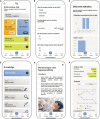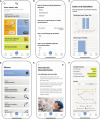Smartphone-based behaviour analysis for challenging behaviour in intellectual and developmental disabilities and autism spectrum disorder - Study protocol for the ProVIA trial
- PMID: 36312036
- PMCID: PMC9610118
- DOI: 10.3389/fnins.2022.984618
Smartphone-based behaviour analysis for challenging behaviour in intellectual and developmental disabilities and autism spectrum disorder - Study protocol for the ProVIA trial
Abstract
Background: Challenging behaviour (CB) comprises various forms of aggressive and problematic behaviours frequently occurring in children with intellectual and developmental disability (IDD) or autism spectrum disorder (ASD). CB often arises from impaired communication or problem solving skills. It is often met with coercive measure due to a lack of alternative strategies on the part of the caregiver, while it also impacts on the caregivers due to the exposure to physical harm and high levels of stress. Within the ProVIA project we developed a smartphone-based tool for caregivers of children with IDD and/or ASD to prevent and modify CB. The ProVIA app systematically helps caregivers to identify specific causes of CB and provides individualised practical guidance to prevent CB and consecutive coercive measures, thus aiming to improve the health and well-being of the children and caregivers.
Methods: In this uncontrolled open trial we will enrol N = 25 caregivers of children aged 3-11 years with a diagnosis of IDD and/or ASD. Participants will use the ProVIA-Kids app for 8 weeks. During the intervention phase, participants will conduct behaviour analyses after each instance of CB. The app will summarise the identified putative causes for the CB in each situation, and provide recommendations regarding the handling and prevention of CB. Furthermore, the app will aggregate data from all available behaviour analyses and identify the most relevant (i.e., most frequently reported) risk factors. Measurement points are at baseline (T0), after the intervention (T1) and 12 weeks after the end of the intervention (follow-up; T2). The primary outcome is the absolute change in parental stress (EBI total scale) between T0 and T1. Further aspects of interest are changes in CB severity and frequency, caregiver mood, satisfaction with the parenting role (EFB-K total scale) and experienced parenting competence (FKE total scale). Pre-post comparisons will be analysed with paired sample t-tests.
Discussion: ProVIA is pioneering structured behaviour analysis via smartphone, assessing predefined causes of CB and providing feedback and recommendations. If this approach proves successful, the ProVIA-Kids app will be a valuable tool for caregivers to prevent CB and improve their own as well as the children's quality of life.
Trial registration: The study is registered at https://www.drks.de/drks_web/navigate.do?navigationId=trial.HTML&TRIAL_IDDRKS00029039 (registered May 31, 2022).
Keywords: autism spectrum disorder; behaviour analysis; challenging behaviour; cognitive behaviour therapy; intellectual disability; mental health application; parent training; parental stress.
Copyright © 2022 Geissler, Buchholz, Meerson, Kammerer, Göster, Schobel, Ratz, Taurines, Pryss and Romanos.
Conflict of interest statement
The authors declare that the research was conducted in the absence of any commercial or financial relationships that could be construed as a potential conflict of interest. The handling editor was currently organizing a Research Topic with the author RP.
Figures




Similar articles
-
ProVIA-Kids - outcomes of an uncontrolled study on smartphone-based behaviour analysis for challenging behaviour in children with intellectual and developmental disabilities or autism spectrum disorder.Front Digit Health. 2024 Sep 13;6:1462682. doi: 10.3389/fdgth.2024.1462682. eCollection 2024. Front Digit Health. 2024. PMID: 39351075 Free PMC article.
-
German Law Reform Does Not Reduce the Prevalence of Coercive Measures in Residential Institutions for Children, Adolescents, and Young Adults With Intellectual and Developmental Disabilities.Front Psychiatry. 2021 Oct 28;12:765830. doi: 10.3389/fpsyt.2021.765830. eCollection 2021. Front Psychiatry. 2021. PMID: 34777067 Free PMC article.
-
Study protocol of the multi-centre, randomised controlled trial of the Frankfurt Early Intervention Programme A-FFIP versus early intervention as usual for toddlers and preschool children with Autism Spectrum Disorder (A-FFIP study).Trials. 2020 Feb 24;21(1):217. doi: 10.1186/s13063-019-3881-7. Trials. 2020. PMID: 32093772 Free PMC article.
-
Acceptability and caregiver-reported outcomes for young children with autism spectrum disorder whose parents attended a preventative population-based intervention for anxiety: A pilot study.Autism Res. 2018 Aug;11(8):1166-1174. doi: 10.1002/aur.1963. Epub 2018 May 15. Autism Res. 2018. PMID: 29761836
-
Communication interventions for autism spectrum disorder in minimally verbal children.Cochrane Database Syst Rev. 2018 Nov 5;11(11):CD012324. doi: 10.1002/14651858.CD012324.pub2. Cochrane Database Syst Rev. 2018. PMID: 30395694 Free PMC article.
Cited by
-
ProVIA-Kids - outcomes of an uncontrolled study on smartphone-based behaviour analysis for challenging behaviour in children with intellectual and developmental disabilities or autism spectrum disorder.Front Digit Health. 2024 Sep 13;6:1462682. doi: 10.3389/fdgth.2024.1462682. eCollection 2024. Front Digit Health. 2024. PMID: 39351075 Free PMC article.
References
-
- Abidin R. R. (1992). The determinants of parenting behavior. J. Clin. Child Psychol. 21 407–412. 10.1207/s15374424jccp2104_12 - DOI
-
- Abler B., Kessler H. (2009). Emotion regulation questionnaire – Eine deutschsprachige fassung des ERQ von Gross und John. Diagnostica 55 144–152. 10.1026/0012-1924.55.3.144 - DOI
-
- American Psychiatric Association (2013). Diagnostic and statistical manual of mental disorders: DSM-5. Washington, DC: American Psychiatric Association. 10.1176/appi.books.9780890425596 - DOI
-
- AWMF (2016). Autismus-spektrum-störungen im kindes-, jugend- und erwachsenenalter – teil 1: Diagnostik. Interdisziplinäre S3-leitlinie der DGKJP und der DGPPN sowie der beteiligten fachgesellschaften, berufsverbände und patientenorganisationen. Germany: AWMF.
-
- AWMF (2021). Autismus-spektrum-störungen im kindes-, jugend- und erwachsenenalter – teil 2: Therapie. Interdisziplinäre S3-leitlinie der DGKJP und der DGPPN sowie der beteiligten fachgesellschaften, berufsverbände und patientenorganisationen. Germany: AWMF.
LinkOut - more resources
Full Text Sources
Medical
Miscellaneous

